

Easy Diacritics and Other Tough Glyphs. In an earlier post I presented a workaround for entering non-native language diacritics (like the grave accent in à la carte) by using InDesign’s built-in spellchecker, which can add them for you.

It’s a slick solution, but it requires some set-up — you have to enter a word incorrectly and have InDesign correct it. I recently learned of a better way to insert any difficult glyph into the text flow, correctly, on the fly: Peter Kahrel’s compose.jsx script for Adobe InDesign or InCopy (Mac/Windows, CS2/CS3, donationware — download instructions are at the end). His script lets you combine any letter with any accent or diacritic using simple mnemonics ? No arcane codes to remember, no need to open the Glyphs panel. If the combination exists as an actual glyph in the typeface, it inserts that; if not, it automatically enters both glyphs and then intelligently kerns them in so it looks like a single glyph.
How it Works When you run the script, a little dialog box appears: Large, multi-script Unicode fonts for Windows computers. <p><a href="index.html"><img src="home.gif" width="76" height="25" border="0" alt="Home" title="Go to the home page of this Web site"></a> <a href="sitemap.html"><img src="sitemap.gif" width="76" height="25" border="0" alt="Site Map" title="Go to a list of all of the pages on this Web site"></a> <a href="fontlist_noscript.html"><img src="fontlist.gif" width="76" height="25" border="0" alt="Font List" title="Go to the menu of Unicode fonts"></a></p> The number of Windows TrueType and OpenType fonts that support Unicode is slowly increasing.
One of the first was Lucida Sans Unicode from Bigelow & Holmes, supplied with a pre-release SDK for Microsoft Windows NT 3.1 in March 1993. Bitstream also had an experimental Unicode font, CyberBit, freely available from Netscape for several years. You need Unicode fonts to display many of the characters for which there are HTML 4.0 character entity references , and to display the Unicode test pages . Combining Diacritical Marks – Test for Unicode support in Web browsers. Combining Diacritical Marks. Combining character. Unicode also contains many precomposed characters, so that in many cases it is possible to use both combining diacritics and precomposed characters, at the user's or application's choice.
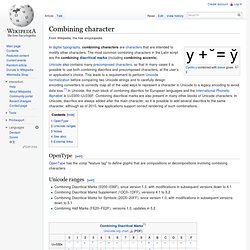
This leads to a requirement to perform Unicode normalization before comparing two Unicode strings and to carefully design encoding converters to correctly map all of the valid ways to represent a character in Unicode to a legacy encoding to avoid data loss.[1] In Unicode, the main block of combining diacritics for European languages and the International Phonetic Alphabet is U+0300–U+036F. Combining diacritical marks are also present in many other blocks of Unicode characters. In Unicode, diacritics are always added after the main character, so it is possible to add several diacritics to the same character, although as of 2010[update], few applications support correct rendering of such combinations.
OpenType[edit] Unicode ranges[edit] Notes[edit] See also[edit] Dead key External links[edit] U0300.pdf (application/pdf-Objekt) Vi. Languages and Character Sets - TEI P5: — Guidelines for Electronic Text Encoding and Interchange. The documents which users of these Guidelines may wish to encode encompass all kinds of material, potentially expressed in the full range of written and spoken human languages, including the extinct, the non-existent, and the conjectural.
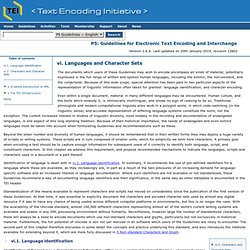
Because of this wide scope, special attention has been paid to two particular aspects of the representation of linguistic information often taken for granted: language identification, and character encoding. Even within a single document, material in many different languages may be encountered. Human culture, and the texts which embody it, is intrinsically multilingual, and shows no sign of ceasing to be so. Transliteration - Bahai9.
From Bahai9 To follow the method of transliteration of Persian and Arabic adopted by the Guardian in all languages using the Roman alphabet "Regarding the transliteration of Persian and Arabic words the House of Justice requests that the method adopted by the beloved Guardian, and which is described in the various volumes of 'The Bahá'í World', be followed, as it permits all languages which use the Roman alphabet to transliterate such terms in the same way throughout the Bahá'í world.

" (From a letter written on behalf of the Universal House of Justice to the National Spiritual Assembly of Panama, July 16, 1979, in Lights of Guidance, no. 367) Transliteration. Transliteration: The representation of a word from a language written in one alphabet to another alphabet.
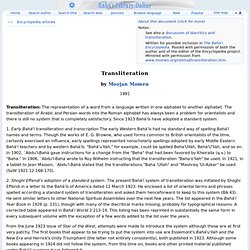
The transliteration of Arabic and Persian words into the Roman alphabet has always been a problem for orientalists and there is still no system that is completely satisfactory. Since 1923 Bahá'ís have adopted a standard system. 1. Early Bahá'í transliteration and transcription The early Western Bahá'ís had no standard way of spelling Bahá'í names and terms. Though the works of E. Bahá'í orthography. Bahá'í orthography refers to the standardized system of Romanization of the Persian or Arabic words and names contained in the literature of the Bahá'í Faith.
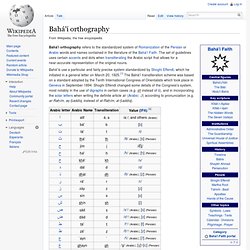
The set of guidelines uses certain accents and dots when transliterating the Arabic script that allows for a near-accurate representation of the original nouns. ^a Real phonetic values of Arabic vary regionally and the table mostly demonstrates the abstract Arabic phonemes. ^b In Persian, the final form of the letter is written undotted. Modified letters[edit] The following are not actually full letters, but rather phonemic diacritics or different orthographical shapes for letters. Diacritics and transliteration. Dying for God: Preface. Inkscape. Draw Freely. CKEditor. Standard editor The following is the standard editor configuration provided with the standard option in the download page.

Rich Text Editor, editor1 Note: This demo uses CKFinder to upload and manage files. CKEditor with lots of features enabled. Bahá'í Calendar - Bahai9. From Bahai9 For the publicly editable wiki article, see WikiPedia:Bahá'í calendar Names of the Bahá'í Week-days Important Baha'i Dates Listing.
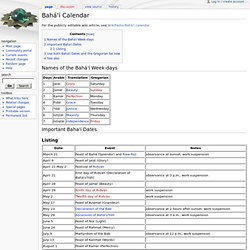
Support Center. If the organizer schedules a session that gives attendees the flexibility to use different audio options, attendees can use the Audio pane to switch between Telephone and Mic & Speakers.
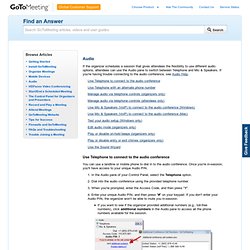
If you're having trouble connecting to the audio conference, see Audio Help. Use Telephone to connect to the audio conference Use Telephone with an alternate phone number Manage audio via telephone controls (organizers only) Manage audio via telephone controls (attendees only) Use Mic & Speakers (VoIP) to connect to the audio conference (Windows) Use Mic & Speakers (VoIP) to connect to the audio conference (Mac) Test your audio setup (Windows only) Edit audio mode (organizers only) Play or disable on-hold beeps (organizers only) Play or disable entry or exit chimes (organizers only) Use the Sound Wizard. Bugzilla Main Page. Bug 28706 – Allow post-parsed documents to be available offline and saved into IndexedDB and made queryable. Bug 28776 – Whitelist global HTML5 semantic attributes and inline meta element.
When can I use @font-face Web fonts? UTS #18: Unicode Regular Expressions. Unicode® Technical Standard #18 Summary This document describes guidelines for how to adapt regular expression engines to use Unicode.
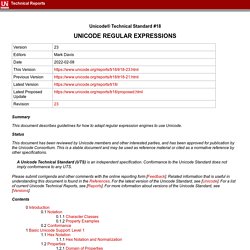
Status This document has been reviewed by Unicode members and other interested parties, and has been approved for publication by the Unicode Consortium. This is a stable document and may be used as reference material or cited as a normative reference by other specifications. A Unicode Technical Standard (UTS) is an independent specification. Please submit corrigenda and other comments with the online reporting form [Feedback]. Contents 0 Introduction Regular expressions are a powerful tool for using patterns to search and modify text. Unicode is a large character set—regular expression engines that are only adapted to handle small character sets will not scale well.
There are three fundamental levels of Unicode support that can be offered by regular expression engines: Level 1: Basic Unicode Support. Character Name Index. Unicode/UTF-8-Zeichentabelle - ab Codeposition 0300. UAX #15: Unicode Normalization Forms. Unicode Standard Annex #15 Summary This annex describes normalization forms for Unicode text. When implementations keep strings in a normalized form, they can be assured that equivalent strings have a unique binary representation. This annex also provides examples, additional specifications regarding normalization of Unicode text, and information about conformance testing for Unicode normalization forms.
Status. Wikisource. سایت پروژه های بهائی. Badi : Baha'i/Badi Developers Institute. This grass-roots initiative aims to allow Baha'i developers a forum to discuss plans to collaborate together to render services both of special interest to the Baha'i community as well as to the wider public (especially projects which are open source and could benefit others as well).
The project has begun with a desire to refine the Text Browser project--a project which aims to allow sophisticated browsing and searching of the Baha'i Writings and other texts as well (now offline due to issues needing fixing). The site bahai-library.com is itself to be made open source at a later date, and these two projects (as well as other open source CMS') are intended to be integrated. Bahá'í Library Online. Main Page - Bahaiquote. News about the Bahá’í Faith. Main Page - Bahaitext, a library of books about the Bahá’í Faith.
Bahaiversity.org. Baha'i Date Schema - TEIWiki. From TEIWiki The following is a Schematron schema to allow an unofficial scheme for the validation of Baha'i dates. The predictability of this schema could vary in the future, if a decision is made by the international governing body of the Baha'i Faith, the Universal House of Justice, as to the site for which Naw-Ruz, the new year, will be determined. At such a time, the beginning of the year will vary by one or two days, so it will not be as easy to detect the validity of dates which might change (in the first or last month, or intercalary days?). It is also certain whether the leap years will follow the current Gregorian calendar or not. Baha'i Reference Library. Main Page - Bahaiwords. Main Page - Bahaimedia. Download - Kalim - Baha'i Writings search software. How to: enter text - Kalim - Baha'i Writings search software. From Kalim - Baha'i Writings search software Thanks for adding text to Kalim.
Bahai9. Main Page - TEIWiki. Wiki2Tei: online converter. Stylesheets. TEI_presentation.pdf (application/pdf-Objekt) Teiu5.pdf (application/pdf-Objekt) Guidelines. The TEI Guidelines for Electronic Text Encoding and Interchange define and document a markup language for representing the structural, renditional, and conceptual features of texts. They focus (though not exclusively) on the encoding of documents in the humanities and social sciences, and in particular on the representation of primary source materials for research and analysis. These guidelines are expressed as a modular, extensible XML schema, accompanied by detailed documentation, and are published under an open-source license. TEI Lite. TEI by Example. Transcriber. Transcriber is a tool for the transcription and annotation of speech signals for linguistic research. It supports multiple hierarchical layers of segmentation, named entity annotation, speaker lists, topic lists, and overlapping speakers.
Two views of the sound pressure waveform at different resolutions may be viewed simultaneously. Various character encodings, including Unicode, are supported. Transcriber is written in Tcl/Tk with the Snack audio library and is therefore available on most major platforms. It is distributed under the GNU General Public License. Bibliography[edit] C. References[edit] Transcriber. Transcriber is a tool for assisting the manual annotation of speech signals. It provides a user-friendly graphical user interface for segmenting long duration speech recordings, transcribing them, and labeling speech turns, topic changes and acoustic conditions. It is more specifically designed for the annotation of broadcast news recordings, for creating corpora used in the development of automatic broadcast news transcription systems, but its features might be found useful in other areas of speech research.
Transcriber is developed with the scripting language Tcl/Tk and C extensions. It relies on the Snack sound extension, which allows support for most common audio formats, and on the tcLex lexer generator. Transcriber is distributed as a free software under GNU General Public License. and has been built to support different platforms (Windows XP/2k, Mac OS X and various Linux). Transcriber - Browse /transcriber/1.5.1. XQuery Tester. Kernow 1.7.